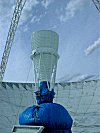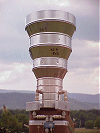
Project Development Photos
(Click on thumbnail to download full picture)
 Array2k Project Update
Array2k Project Update
(Click on thumbnail to download full picture)
Attn. Journalists and Photo Editors: please check our Fair Use Policy before reproducing any of these images. Thank you.
| Since the earliest days of the Project Argus search, our members have been discussing technologies required to combine multiple small dishes into a meaningful SETI array. SETI League member and noted space artist Jon Lomberg has contributed this artist's conception of Array2k, the next-generation radio telescope now in preliminary design phase at SETI League headquarters. |
 Jon Lomberg |
| In January 2000, Executive Director H. Paul Shuch met in Sri Lanka with Advisory Committee member Sir Arthur C. Clarke, to discuss the design of our Array2k SETI antenna. Though well known as a novelist, Clarke has an impressive engineering background, and is considered the father of communications satellites (as celebrated in song). |
 SETI League |
|
The seven dishes of the SETI Institute's Rapid Prototype Array provide a test bed for new technology to be used in their ambitious Paul Allen Array (formerly called the One Hectare Telescope). Technology sharing is allowing SETI League engineers to apply some of these concepts in the development of our own (somewhat more modest) Array2k design. More RPA photos are available here. |
 SETI League |
| This detail shows one way of mounting the SETI League hydrogen-line feedhorn to a surplus TVRO dish antenna. Four 1/4 inch holes are drilled in the outer walls of the choke ring, as far back toward its shorted end as possible, and 1/4-20 screws and nuts are used to attach the feed assembly to the dish's existing mounting arms. The feedhorn is then slid in and out of the rigidly mounted choke ring until proper illumination is achieved. A similar feed design is contemplated for the Array2k design. |
 N6TX photo |
|
As design work continues on our Array2k radio telescope project, it is possible to add a bit more detail to our artist's conception. This new sketch by SETI League intern Aurore Simonnet provides a perspective view of the planned dish placement. See more of Aurore's work on her personal website. |
 A. Simonnet |
 | Engineers at CSIRO in Australia have developed some elegant corrugated waveguide feedhorns for use by the SETI Institute's Project Phoenix targeted search. The one at left, installed on a 100 foot dish at the Georgia Tech Woodbury Research Facility, covers 1 to 7 GHz with dual polarizations. For our Array2k effort, The SETI League is developing much narrower-band corrugated feedhorns. At right is an L-band feed constructed out of surplus materials, at a cost many orders of magnitude below the feeds made by our Australian colleagues. |
 SETI League |
| SETI League executive director Dr. H. Paul Shuch explains the latest Array2k feed design at the Society of Amateur Radio Astronomers conference at NRAO Green Bank WV. See more SARA photos here. |
 SETI League |
See also photos of our Very Small Array (VSA) prototype.
Click here for lots more pictures.
email the Webmaster | entire website copyright © The SETI League, Inc. this page last updated 28 December 2002 |
Top of Page |